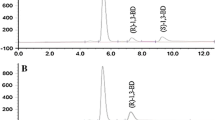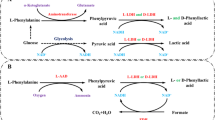Abstract
Discovery of new bacterial strains with fast identification in a miniaturized system was performed for the synthesis of optically active L-tert-butyl leucine. With tert-butyl leucine amide as nitrogen source, one bacterial strain with high conversion and high enantioselectivity was discovered among 120 isolated microorganisms from local soils and identified as Mycobacterium sp. JX009. Glucose and ammonium chloride were examined as the good carbon source and nitrogen source for the cells’ growth separately. The cells grew better at 30 °C and at pH 7.5 with higher activity of 2,650 U/l in comparison with other conditions. Cells’ stability was improved by immobilization on synthetic resin 0730 without pretreatment. Tert-butyl leucine amide (30 mM) was successfully hydrolyzed by immobilized cells and examined as the highest chemical concentration that cells could endure. After six reaction cycles, the immobilized cells retained 90% activity with production of L-tert-butyl leucine in 98% ee. The results firstly reported the application of new bacterial strain in the hydrolysis of tert-butyl leucine amide to produce optically active L-tert-butyl leucine in an efficient way with investigation in detail.





Similar content being viewed by others
References
Menzel, A., Werner, H., Altenbuchner, J., & Groeger, H. (2004). Engineering in Life Sciences, 4, 573–576.
Bruggink, A., Roos, E. C., & Vroom, E. (1998). Organic Process Research & Development, 2, 128–133.
Helimchen, G., & Pfaltz, A. (2000). Accounts of Chemical Research, 33, 336–345.
Jarvo, E. R., & Miller, S. J. (2002). Tetrahedron, 58, 2481–2495.
Izumiya, N., Fu, S. C. J., Birnbaum, S. M., & Greenstein, J. P. (1953). The Journal of Biological Chemistry, 205, 221–230.
Viret, J., Patzelt, H., & Collet, A. (1986). Tetrahedron Letters, 27, 5865–5868.
Corey, E. J., & Link, J. O. (1992). Journal of the American Chemical Society, 114, 1906–1908.
Tuner, N. J., Winterman, J. R., McCague, R., Parratt, J. S., & Taylor, S. J. C. (1995). Tetrahedron Letters, 36, 1113–1116.
Liu, S. L., Song, Q. X., Wei, D. Z., Zhang, Y. W., & Wang, X. D. (2006). Preparative Biochemistry & Biotechnology, 36, 235–241.
Liu, S. L., Wei, D. Z., Song, Q. X., Zhang, Y. W., & Wang, X. D. (2006). Bioprocess and Biosystems Engineering, 28, 285–289.
Grabley, S., Keller, R., & Schlingmann (1987). EP 0 141 223.
Kragl, U., Vasic-Racki, D., & Wandrey, C. (1996). Bioprocess Engineering, 14, 291–297.
Krieg, L., Ansorge-Schumacher, M. B., & Kula, M. R. (2002). Advanced Synthesis & Catalysis, 344, 965–973.
Zhang, J., Duetz, W. A., Witholt, B., & Li, Z. (2004). Chemical Communications, 18, 2120–2121.
Laumen, K., Ghisalba, O., & Auer, K. (2001). Bioscience, Biotechnology, and Biochemistry, 65, 1977–1980.
Joeres, U., & Kula, M. R. (1994). Applied Microbiology and Biotechnology, 40, 599–605.
Schlege, H. G. (1985). Allgemeine Mikrobiologie (6th ed.). Stuttgart: Thieme Verlag. 174.
Acknowledgement
Support for this research by the Zhejiang Province Science Foundation (No. y4080311) is gratefully acknowledged.
Author information
Authors and Affiliations
Corresponding author
Rights and permissions
About this article
Cite this article
Jin, JZ., Chang, DL. & Zhang, J. Discovery and Application of New Bacterial Strains for Asymmetric Synthesis of L-Tert-Butyl Leucine in High Enantioselectivity. Appl Biochem Biotechnol 164, 376–385 (2011). https://doi.org/10.1007/s12010-010-9141-7
Received:
Accepted:
Published:
Issue Date:
DOI: https://doi.org/10.1007/s12010-010-9141-7




